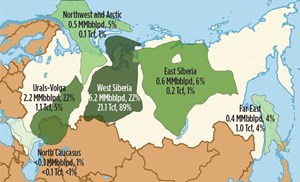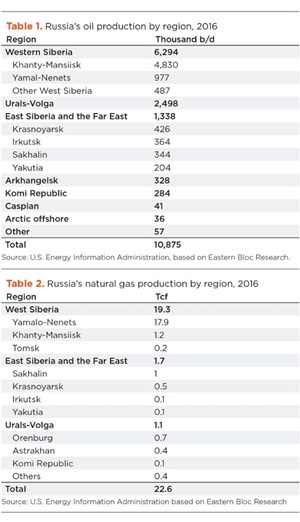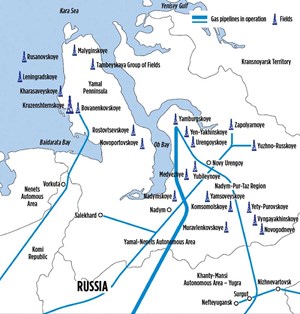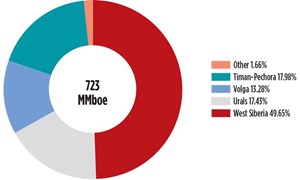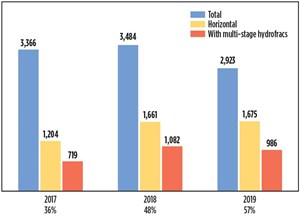The catastrophic intersection of the OPEC-Russia price war and the Covid-19 pandemic heaps huge financial burdens on a Russian oil and gas industry already beleaguered by U.S. sanctions and West Texas shale. Production cuts and lost revenue challenge a broad range of Russian initiatives, from revitalizing mature assets to expanding Arctic E&P. Tax incentives to promote these efforts have lost their luster at current prices, and investors are in short supply.
Criticality is amped, because oil and gas make up more than 60% of Russia’s exports and provide more than 30% of the country’s GDP. The current price collapse raises ugly specters of the past. In 2014, a price collapse drove the ruble’s value down 59% relative to the U.S. dollar in just six months, according to Investopedia figures.
Oil prices, which had been expected to rise in 2020, started to come unspooled when Russia, eyeing U.S. shale production, refused in March to accept OPEC production cuts aimed at supporting prices.
Russia is understandably not fond of U.S. shale production and views it as the biggest beneficiary of OPEC+ cuts. Just to be clear, in November 2019, Russian President Vladmir Putin called shale production “barbaric” and a destroyer of the environment.
In response to the failed OPEC+ agreement, Saudi Arabia, of course, opened the valves—just in time for a record-setting, pandemic-driven plunge in demand.
As with the rest of the industry, the failed agreement came at a considerable cost to Russia. Lukoil co-owner Leonid Fedun, in a March article in Forbes, said Russia stood to lose between $100 million and $150 million per day as a result. That was just the opening round.
Staring into the price abyss soon produced an industry agreement to reduce global output by about 10%. In late April, Russian Energy Minister Alexander Novak told Reuters that he believed global demand had already hit bottom after dropping by 20 MMbopd to 30 MMbpod, and that Russia planned to cut production about 2 MMbopd, or 19% from February levels. He then proposed that once demand returned, OPEC+ should shift strategy from stockpiles and balancing supply and demand, to targeting market share.
ARCTIC CANARY
Russia’s vast Arctic E&P plans may be the first to take a hit, presaging difficulties across the Russian oil and gas sector. The costly, harsh-environment undertaking, largely focused on gas, is already hampered by sanctions, particularly offshore, where funding, technology and expertise are tightly squeezed.
The sanctions were implemented in March 2014 after Russia annexed Crimea and used force in Ukraine; renewed in 2017; and in 2018, new sanctions were applied over alleged meddling in the 2016 U.S. presidential election.
The far-reaching results constrain E&P development and other related infrastructure projects, such as the Nord Stream 2 gas pipeline. The Gazprom project aims to move as much as 55 Bcm of Siberian natural gas per year from Russia to Germany via the Baltic Sea. But sanctions have stalled construction, with just 10% of the pipeline remaining. U.S. Energy Secretary Dan Brouillette predicts a long delay; Gazprom thinks otherwise.
Russian tax incentives may be lacking in the face of depressed demand and prices. The Arctic appears particularly vulnerable. For example, Rosneft announced in February that it would invest $134 billion in its Vostok Oil Project on the Taymyr Peninsula. However reimbursement of infrastructure costs is dependent on crude prices that have since tanked. While Russia has offered to provide Rosneft with tax breaks, the offer stands, so long as oil trades above $42.45/bbl this year, and more in coming years.
Summing up the circumstances, Vavily Tanurkov, director of Russia’s ACRA Ratings, told Bloomberg that while the Vostok project will likely remain a priority, low prices may “minimize investment” in the project.
The tax breaks are part of January legislation setting out $300 billion of incentives for Arctic ports, factories, and oil and gas development. That includes a 5% production tax break for the first 15 years.
Canada, frozen in place by its Arctic moratorium, is paying particular attention. Projects in the eastern Arctic near Canada’s Beaufort Sea are even more highly incentivized, with no extraction tax for the first 12 years of operation, reports Canadian Broadcasting Corporation.
RUSSIA OVERVIEW
For more than a decade, Russia led the world in oil production. In 2018, that changed as rapidly increasing U.S. oil output first exceeded Saudi Arabia, and then in June and August surpassed Russia for the first time since February 1999.
In 2019, Russia produced about 10,847,000 bpd of crude and condensate, second behind the U.S. (12,232,000 bpd) and ahead of Saudi Arabia (9,826,000 bpd). Total global production of crude and condensate was 82,253,000 bpd, according to EIA figures. The latest EIA estimates for gas output, as of 2017, had Russia at number two in annual gas production with 23.508 Tcf after the U.S. at 27.291 Tcf.
The country’s huge hydrocarbon assets are scattered across a vast landscape, Fig. 1. EIA lists seven primary oil-producing regions: Western Siberia, Urals-Volga, East Siberia and the Far East, Arkhangelsk, Komi Republic, Caspian and Arctic offshore. Natural gas comes primarily from three of those—West Siberia, East Siberia and Far East, and Urals-Volga, Tables 1 and 2.
OPERATOR NOTES
The top Russian oil companies are generally considered to be Rosneft, Lukoil, GazpromNeft, Surgutneftegas, and Tatneft. Top gas companies are Gazprom, Novatek, Rosneft, Lukoil and Surgutneftegas. What follows is a snapshot of recent news and activity gleaned from company media releases and investor reports.
Gazprom. Citing a long list of activities, Gazprom said in April that it is carrying on with major investments. Within the Eastern Gas Program, the company continues to ramp up its production and gas transmission capacities. Production drilling at Kovyktinskoye field in the Irkutsk Region is currently running seven rigs, with a jump to 18 units in 2021. On the Yamal Peninsula, Gazprom plans to bring 52 new gas wells onstream at Bovanenkovskoye field in 2020. At Kharasaveyskoye field, the company planned to start production drilling amidst ongoing construction of pipeline infrastructure.
Other activities include expansion of gas treating facilities at Chayandinskoye field in Yakutia for an annual output of 25 Bcm of gas. Completion of a second compressor station on the Power of Siberia gas pipeline was planned, along with continued construction of the pipeline section between Kovyktinskoye and Chayandinskoye in the third quarter of this year. The company also reports that the Sakhalin-Khabarovsk-Vladivostok gas pipeline is undergoing an expansion, with 66 km of about 390 km built between Komsomolsk-on-Amur and Khabarovsk.
In its most recent investor presentation, Gazprom said it expects to grow natural gas production to support Russian markets, as well as exports to Europe and China. Pipelines will remain the backbone of its transportation infrastructure and the key to E&P development.
Recent achievements include the start of oil and gas production at Eastern Siberia’s Chayandinskoye field, the launch of full-scale development of the Kharasaveyskoy project in Yamal, and numerous gas processing, pipeline and LNG projects. Field commissioning activity includes Chayandinskoye in 2019, with prospective commissions in 2020-2025 for Kovyktinskoye, Kharasaveyskoye-more, and Yuzhno-Kirinskoye fields.
To ensure cost-competitive gas for decades, the company’s plans through 2030 include development of main gas production centers, and onshore and offshore fields. That includes fields on the Yamal Peninsula; the NADYM-PUR-TAZ area, including OB and TAZ Bays; Eastern Siberia and the Russian Far East; and the Sea of Okhotsk on the east coast.
Gas reserves of Yamal’s Kruzenshternskoye field were raised to 2 Tcm, based on results of directional wells. The drilling increased Kruzenshternskoye field’s recoverable gas reserves by 360 Bcm.
The field forms part of the Bovanenkovo production zone, and it is the basis for the development of the major gas production center on the Yamal Peninsula, Fig. 2. The Bovanenkovo production zone at the Yamal gas production center includes three fields: Bovanenkovskoye, Kharasaveyskoye, and Kruzenshternskoye.
Kruzenshternskoye field is west of Bovanenkovskoye field, partly onshore the Yamal Peninsula but mostly in the waters of the Kara Sea.
To collect more precise reserves data, Gazprom said it drilled a directional exploration well from the coast of Sharapov Shar Bay. The well is 4.9 km long, including a 3.9-km seaward deviation. Gazprom Geologorazvedka carried out geological exploration at Kruzenshternskoye field.
In addition, Gazprom has drilling rights in the Sopochny Block (Tazovsky District, Yamal-Nenets Autonomous Area), where it estimates a resource potential exceeding 500 million tons of fuel-equivalent.
In a November 2019 report, Gasprom’s board said that while the U.S. would remain the main producer of shale gas for the long term, shale gas production outside North America would not have a significant impact on the global gas market or future activities of Gazprom.
Going into the winter, Gazprom said its Unified Gas Supply System facilities had potential for daily deliverability of 843.3 MMcm, with working inventories of about 72 Bcm (11.4 Bcm going to European facilities). The company reported 89 gas treatment and pre-treatment units in operation, with additional capacity in the works, including projects at Urengoyskoye and Bovanenkovskoye fields.
Gazprom in October completed feeding natural gas into the Power of Siberia gas pipeline. The gas from Chayandinskoye field in Yakutia had reached a gas metering station near Blagoveshchensk on the Chinese border, setting up the start of Russian pipeline gas supplies to China. The next step involved moving gas into the transborder crossing under the Amur River.
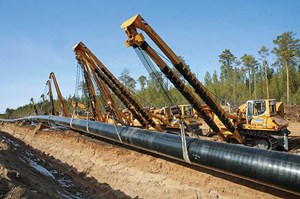
The largest gas transmission pipeline in the Russian system, its length is about 3,000 km and has an export capacity of 38 Bcm per year. The line fulfills a May 2014 Gazprom and China National Petroleum Corporation agreement. In late 2022, the Power of Siberia pipeline will start to receive gas from one more field, Kovyktinskoye, which serves as the basis for the Irkutsk gas production center, Fig. 3.
Gazprom and Irkutsk Oil Company in October said they would explore and develop the Sobinskoye and Paiginskoye fields, as well as the Paiginsky Block, in the Krasnoyarsk Territory. A feasibility study was underway. Gazprom is the license-holder for Sobinskoye oil, gas and condensate field. Irkutsk Oil Company is one of the largest independent hydrocarbon producers in Russia.
Lukoil. Tax incentives have been key to steady gains in production from hard-to-recover reserves, says Lukoil. Oil production from low-permeability rock and heavy crude assets increased from 65,000 bpd in 2015 to 103,000 bpd in 2018 and 127,000 bpd in 2019. The company plans to commission 200 production wells in low-permeability reserves during 2020. Heavy oil efforts are focused on steam generation, pressure maintenance, increasing transport capacity, and drilling cost optimization.
The company reports 14.33 Bboe of proven hydrocarbon reserves in Russia at the end of 2018. Its 2018 production of 723 MMboe came from five regions, with West Siberia dominating at 46.65% of production, followed by Timan-Pechora, Volga, the Urals and the Kaliningrad Region, Fig 4.
Lukoil’s upstream strategy is focused on sustainable organic growth in its existing resource base. In a March 2020 report, the company pointed to efforts to develop existing gas reserves and improve efficiency at mature fields, which have increased production over the past three years, from 2.24 MMboed in 2017 to 2.36 MMboed in 2019.
In West Siberia, Lukoil said its advantages include a stable region for reinvestment, low cost-per-meter drilling, experience, and growth potential based on large reserves. The growing use of horizontal wells with three-string designs, and neural networks to control reservoir pressure maintenance, have slowed production declines. Thus, a 9.6% drop from 2015 to 2016 was limited to a 2.5% drop from 2018 to 2019, when total oil production was about 700,000 bpd.
Lukoil said efficiency is achieved increasingly through technology development and scale-up, lighter well construction methods, batch drilling, and implementation of “intellectual field” well completions to support management and scaling of mature fields with neural networks.
Three-string well designs are increasing drilling speed and reducing cost per well by about 20%, said Lukoil. During 2018-2019, it completed 104 horizontal wells with three-string designs, including 21 multilateral wells.
Small-diameter wells have reduced cost per well by about 50%, due to the lower-capacity rigs required for the task and less metal used in well construction, said Lukoil. In 2018-2019, it completed 119 of these wells. The company also credited energy-efficient pumps at pump stations and downhole permanent magnet engines with a 10%-to-15% reduction in electricity costs.
Production started in early April at three oil fields in the Komandirshorskaya Group in the Nenets Autonomous District—Komandirshorskoye, North Komandirshorskoye and West Komandirshorskoye. The initial recoverable reserves of the three fields are estimated at 11 million tons.
Produced oil is transported by a winter road to the Kharyaginsky Central Oil and Gas Gathering Point for further treatment. The Komandirshorskaya Group infrastructure development project plans include construction of a gathering system and capacities for oil and gas treatment, including pipelines, control facilities, measuring units, separator units, tanks, a 35-kW overhead power line and a substation to deliver power to the fields’ facilities.
Development of reserves in the Nenets Autonomous District is one of Lukoil’s strategic priorities, and the company plans to start development of the neighboring North Mishvanskoye and Simbeyskoye fields in the next few years.
Rosneft. Enhancing yields is Rosneft’s key focus. It is pursuing that objective through lower lifting cost and well costs, and through structural and technological changes, including drilling rig automation and automatic well data collection systems. Rosneft also expects tax incentives will lead to reduction of production decline rates in assets, including Samotlor field.
Efforts in liquids production include development of large, new projects with incremental production growth of up to 140.3 MMbbl, up 27% from 2018. In addition, accelerated development of hard-to-recover, low-tax reserves is expected to ensure production growth of up to 154.7 MMbbl, up 12% vs. 2018.
Rosneft points to an increasing percentage of horizontal wells and wells with multi-stage hydrofracs. In 2017, horizontal completions made up 36% of total wells and 57% in 2019, Fig. 5.
Related to an increasing share of horizontal wells, the company said it has widely applied complex well completion methods in horizontal wells with multi-stage hydro fracs up to 34% of the 2019 total, up 3% from 2018. The number of multilateral wells increased by 80%, Y-o-Y. Liquids production per horizontal well increased 11% vs. 2018, said Rosneft.
Near-term plans include full development of large-scale projects in the Erginskiyblock, Chaprovskoye, Severo-Danilovskoye, Lodochnoye, and Severo-Komsomolskoye fields. The efforts are aimed at achieving output of more than 160,000 bopd, total field production by 2022.
- Management issues- Dallas Fed: Activity sees modest growth; outlook improves, but cost increases continue (October 2023)
- Dallas Fed: Oil and gas expansion continues; cost pressures, supply-chain delays persist (November 2022)
- Digital transformation: Harnessing the power of data science (September 2022)
- Oil and Gas in the Capitals: Resupplying Europe: Questions (August 2022)
- Russian Regional Report: Isolation 2.0 (June 2022)
- The Last Barrel: What a difference a war makes (May 2022)
- Applying ultra-deep LWD resistivity technology successfully in a SAGD operation (May 2019)
- Adoption of wireless intelligent completions advances (May 2019)
- Majors double down as takeaway crunch eases (April 2019)
- What’s new in well logging and formation evaluation (April 2019)
- Qualification of a 20,000-psi subsea BOP: A collaborative approach (February 2019)
- ConocoPhillips’ Greg Leveille sees rapid trajectory of technical advancement continuing (February 2019)

